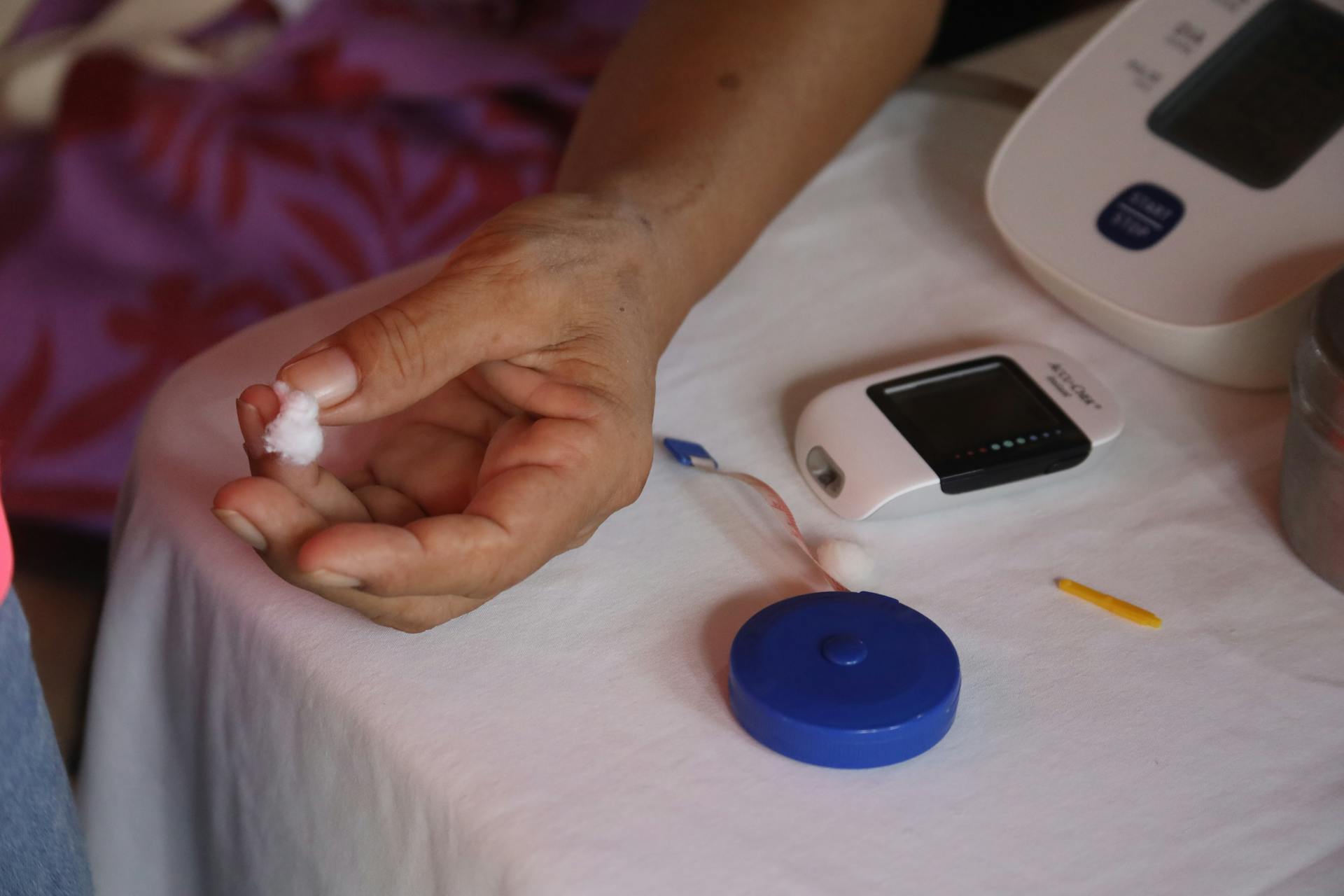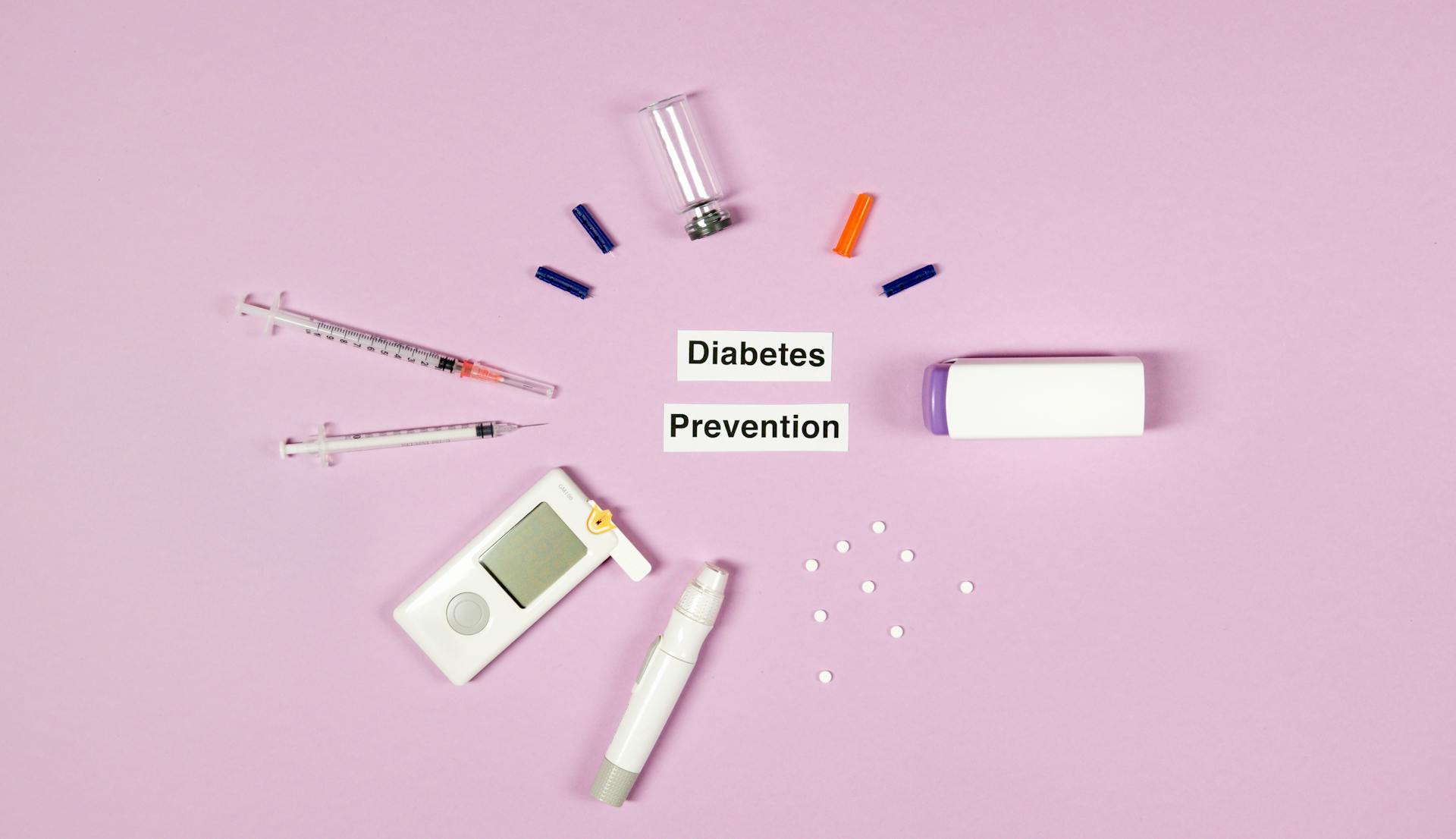
Managing your dog's diabetes requires a good understanding of blood sugar levels. A normal blood glucose level for dogs is between 60-120 milligrams per deciliter (mg/dL).
Dogs with diabetes typically have high blood sugar levels, often above 200 mg/dL. This is because their bodies don't produce enough insulin to regulate blood sugar.
Your veterinarian will likely take a blood sample to determine your dog's baseline blood sugar level. This will help you understand how their levels change throughout the day.
Blood sugar levels can fluctuate throughout the day, even in dogs with diabetes. This is why regular monitoring is crucial to maintaining your dog's health.
If this caught your attention, see: Bernese Mountain Dog Energy Level
What Is Diabetes in Dogs?
Diabetes in dogs is a common endocrine disorder that affects the way their body regulates blood sugar levels.
It's caused by a lack of insulin production or an inability to use insulin effectively, leading to high blood sugar levels.
Dogs with diabetes typically have a higher-than-normal blood glucose level, which can damage their organs and tissues over time.
Their pancreas, which normally produces insulin, is unable to keep up with their body's needs, resulting in high blood sugar levels.
Symptoms can include increased thirst and urination, weight loss, and blurred vision.
Dogs with diabetes may also experience vomiting, diarrhea, and lethargy.
High blood sugar levels can damage their kidneys, eyes, and nerves, leading to serious health complications.
Their lifespan can be significantly reduced if left untreated or poorly managed.
A diagnosis of diabetes is typically made through a combination of physical examination, laboratory tests, and medical history.
A unique perspective: Dog Training Levels
Causes and Types
Diabetes in dogs primarily manifests in two forms: Insulin-deficiency diabetes (IDD) or type 1, where the body doesn't produce enough insulin, and insulin-resistance diabetes (IRD) or type 2, where the body produces insulin but loses its ability to utilize it effectively over time.
IDD is more common in dogs, while IRD is often linked to conditions like obesity and Cushing's disease, which can be a result of genetic factors and environmental triggers. Certain breeds, overweight dogs, or those with hormonal and metabolic disorders are at a higher risk.
Here are some common causes of diabetes in dogs:
- Genetic predisposition
- Infection
- Drugs
- Obesity
- Immune-mediated disease
- Pancreatitis
Female dogs are affected approximately twice as often as males, and certain breeds are also more susceptible, such as Australian Terriers, Schnauzers, Cavalier King Charles Spaniels, Labradors, Golden Retrievers, Dachshunds, Poodles, and Pugs.
What Is Mellitus?
Mellitus is a type of diabetes that affects dogs, and it's characterized by a high blood sugar level that can't be controlled on its own.
The pancreas is unable to secrete enough insulin, or the cells have become resistant to insulin, leading to this condition.
Diabetes mellitus is almost exclusively Type 1 insulin-dependent diabetes mellitus (IDDM) in dogs, meaning they can't be treated with diet or oral drugs alone.
Regular injections of insulin are necessary to maintain their blood glucose levels.
Female dogs are affected approximately twice as often as males, and certain breeds are more susceptible, such as Australian Terriers and Schnauzers.
A different take: Dog Insulin Types
Types and Causes
Diabetes in dogs primarily manifests in two forms: Insulin-deficiency diabetes (IDD) or type 1, where the body doesn't produce enough insulin.
Insulin-resistance diabetes (IRD) or type 2 is often linked to conditions like obesity and Cushing's disease, which can cause the body to lose its ability to utilize insulin effectively over time.
For your interest: Dog Body Language with Other Dogs

Certain breeds, overweight dogs, or those with hormonal and metabolic disorders such as Cushing's Disease, are at a higher risk of developing diabetes.
Your vet will conduct tests to determine the type of diabetes affecting your dog.
The exact cause of diabetes in dogs can be complex and often a combination of genetic factors and environmental triggers.
Diabetes in dogs is almost exclusively Type 1 insulin-dependent diabetes mellitus (IDDM) and cannot be treated purely with diet or oral drugs.
Here are some common causes of diabetes in dogs:
- Genetic predisposition
- Obesity
- Immune-mediated disease
- Pancreatitis
- Drugs
- Infection
Diabetes in dogs is usually diagnosed between the ages of 4 and 14 years, with most dogs diagnosed between 7 and 9 years of age.
Symptoms and Diagnosis
Symptoms of high blood sugar levels in dogs can be a real challenge to recognize, but early detection is key. Excessive thirst and urination are common early signs, as your dog's body tries to flush out excess glucose.
Increased appetite and weight loss despite eating more can also be indicators. Some dogs may even become more lethargic or inactive, while others might display restlessness, especially at night.
Here are some common symptoms to look out for:
- Increased thirst (polydipsia)
- Increased urination (polyuria)
- Increased appetite (polyphagia)
- Weight loss
- Eye cataracts
- Urinary tract infection
A thorough physical examination and review of your dog's medical history are usually the first steps in diagnosing diabetes. Your veterinarian may also perform blood and urine tests to check for high glucose levels and rule out other conditions.
Recognizing Symptoms
Recognizing symptoms of diabetes in dogs is crucial for early detection and effective management. Excessive thirst and urination are common early signs, often accompanied by weight loss despite increased appetite.
A diabetic dog may become more lethargic or inactive, showing increased appetite or restlessness, particularly at night. Changes in elimination habits can be an early sign, such as unusual accidents in the house.
If left untreated, diabetes in dogs can progress rapidly, leading to symptoms like loss of appetite, lethargy, urinary tract infections, and skin infections. Long-term, unregulated diabetes can cause health complications like cataracts, seizures, kidney failure, and an enlarged liver.

Some common clinical signs of diabetes include increased thirst (polydipsia), increased urination (polyuria), increased appetite (polyphagia), weight loss, eye cataracts, and urinary tract infections.
Here are some key symptoms to look out for:
- Marked increase in urination
- Excessive thirst
- Increase or decrease in appetite
- Breath that smells “sweet”
- Lack of energy
- Unexplained weight loss
Regular check-ups with your veterinarian, along with consistent monitoring and proper management at home, can help keep diabetes under control.
Spotting the Difference
Diabetes in dogs can be a bit tricky to diagnose, but there are some key differences between canine and human diabetes.
Diabetes in dogs is usually similar to Type 1 diabetes in humans, where the body fails to produce sufficient insulin. This is in contrast to Type 2 diabetes, which is the most common form in humans, where the body still produces insulin but uses it inefficiently.
Some common clinical signs that indicate diabetes in dogs include increased thirst, increased urination, increased appetite, weight loss, eye cataracts, and urinary tract infections.
Here are some key differences between canine and human diabetes:
It's essential to keep in mind that diabetes in both dogs and humans is manageable, and with proper care and attention, your furry friend can lead a happy and healthy life.
How Is Diagnosed?

Diagnosing diabetes in dogs involves a thorough physical examination and review of the dog's medical history. The most common symptoms that may trigger a veterinarian to suspect diabetes include increased thirst, urination, and weight loss.
A baseline bloodwork test, which includes a CBC and Blood Chemistry, is the fundamental diagnostic test. This test checks various factors, especially the persistent elevation of blood glucose levels.
Consistently elevated blood glucose levels indicate diabetes, while a one-off high reading may be due to stress or other temporary factors.
Your veterinarian will also check the urine test results for glucose levels and bacteria growth. High glucose levels in the urine can indicate diabetes, and bacteria growth may indicate a urinary tract infection.
An abdominal ultrasound may be performed to rule out concurrent pancreatitis. This test can help your veterinarian make a clear diagnosis.
The results of the blood test, including the fructosamine level, will also be examined to look at the average blood glucose level over the last three weeks.
You might enjoy: Deeper Level
Diagnosing and Treating

Diagnosing diabetes in dogs typically begins with a thorough physical examination and a detailed review of the dog's medical history. The most common symptoms that may trigger a veterinarian to suspect diabetes include increased thirst, urination, and weight loss.
A baseline bloodwork (CBC and Blood Chemistry) is the fundamental diagnostic test, which will check various factors, especially the persistent elevation of blood glucose levels.
Consistently elevated readings in blood glucose levels indicate diabetes, while a one-off high reading may be due to stress or other temporary factors.
Additional tests are often used to confirm the diagnosis and rule out other possible conditions.
Diabetes is diagnosed through a combination of the dog's history, clinical signs, and the results of a blood test and urine test.
Diabetic dogs will show high levels of glucose in their blood and urine, and there should never be glucose in the dog's urine.
A veterinarian may also check the fructosamine level in the dog's blood test results to look at the average blood glucose level over the last three weeks.
A fresh viewpoint: Dog Level

The results of the urine test will be examined for bacteria growing in the urine, which will be treated by antibiotics if a urinary tract infection is present.
An abdominal ultrasound will be performed to rule out concurrent pancreatitis.
The most important facet of managing diabetes mellitus is good communication with the owner, as owners need to realize the variables involved with treatment and the money and time commitment required.
Here are some questions and concerns that owners should consider when managing their dog's diabetes mellitus:
- What is the patient's home feeding schedule?
- What diet and how much of it is fed at each meal? Are any treats given (be specific)?
- Are there other pets in the household? If so, can they be separated from the patient at meal time?
- Is the owner able to administer insulin injections? Is he or she willing to learn?
- Does the patient need to lose weight? Gain weight? Neither?
- Is the owner able to perform glucose curves at home? If so, recommend purchasing a quality glucometer that is reliable in dogs (e.g., AlphaTRAK 2).
Hypoglycemia
Hypoglycemia can be a serious condition that requires prompt treatment.
A hypoglycemic episode typically starts with lethargy and weakness, and can progress to disorientation and even seizures if left untreated.
Feeding a meal can help treat a hypoglycemic episode, or you can apply a syrup to the buccal membranes for quick relief.
With more advanced levels of hypoglycemia, emergency intervention using intravenous 50% dextrose may be necessary.
Treatment and Management
Insulin therapy is the cornerstone of treatment for most instances of diabetes in dogs. It's a critical component in managing the disease and must be personalized as dogs may react differently to the various types of insulin available.
A consistent diet is essential for diabetic dogs, consisting of high-quality protein, complex carbohydrates, and fiber, which help slow glucose absorption. This ensures a steady blood glucose level between meals.
Regular physical activity is beneficial for all dogs, but even more so for dogs living with diabetes. Moderate but consistent exercise helps improve glucose metabolism, maintaining their blood sugar levels and overall health.
Diabetic dogs need regular veterinary check-ups to monitor blood glucose levels, which can be done in the form of spot glucose checks, plotting levels throughout the day, and looking at other markers to gain data about the recent history of blood glucose values.
To manage diabetes at home, maintaining a steady routine, including a consistent schedule, diet, and regular exercise, is key. Regular monitoring is also a mainstay of home management, but you're not alone in this journey – maintaining good communication with your vet is essential.
Here's an interesting read: How to Treat Fading Puppy Syndrome at Home
A regular feeding schedule and dosing schedule are crucial to maintain stable blood sugar levels throughout the day. This means adjusting your daily routine to ensure your pet's insulin needs are met.
Managing diabetes in dogs requires a team effort between you and your veterinarian. They will guide you through the process, help you determine what signs may indicate a need for adjustments, and ensure the best possible control of your pet's diabetes.
Here's a summary of the key factors to consider when managing diabetes in dogs:
- Insulin therapy: the cornerstone of treatment
- Consistent diet: high-quality protein, complex carbohydrates, and fiber
- Regular physical activity: moderate but consistent exercise
- Regular veterinary check-ups: to monitor blood glucose levels
- Home management: maintaining a steady routine and regular monitoring
- Adjusting daily routine: to ensure your pet's insulin needs are met
Living with Diabetes
Maintaining a regular feeding schedule is crucial to keep your dog's blood sugar levels stable throughout the day. This schedule will help you determine the right amount of insulin to administer.
Your dog's diet should primarily consist of complex carbohydrates and fibers, which help slow the absorption of glucose in the body. This ensures a steady blood glucose level between meals.
Regular physical activity helps improve your pet's glucose metabolism, maintaining their blood sugar levels and overall health. However, it's essential to keep exercise routines steady and avoid sudden spikes in activity.
Consider reading: Skin Relief for Dogs with Allergies
Monitoring blood glucose levels is vital to ensure your dog's diabetes is being managed effectively. You can do this by tracking their blood glucose levels at home with a glucometer, such as the AlphaTRAK 2.
Sticking to a good routine and following your vet's treatment plan is essential for managing your dog's diabetes. This includes giving injections 12 hours apart, keeping insulin in the fridge, and administering injections under the skin.
Here are some essential tips to keep in mind:
- Give your dog their injection with or directly after food
- Stick to your plan of giving injections 12 hours apart
- Keep insulin in the fridge and away from light
- Administer insulin injections under the skin, as shown by your vet
- Keep a regular high fibre diet for your dog
- Exercise your dog around the same time every day
Monitoring
Monitoring your dog's blood sugar levels is crucial to managing their diabetes. You'll need to work closely with your veterinarian to determine the best monitoring schedule for your pet.
Regular veterinary visits are essential for assessing and adjusting your pet's treatment plan as needed, ensuring the best possible control of their diabetes. Your veterinarian will guide you through this process.
You can also track your dog's blood glucose levels at home with newer in-home BG monitoring kits, which may be recommended by your vet. These kits can give you valuable insight into how well their diabetes is being managed daily.
If this caught your attention, see: Best Food for Gassy Dogs
To monitor your dog's blood sugar levels, you'll need to perform spot glucose checks, plot levels throughout the day, and look at other markers to gain data about the recent history of blood glucose values. This can be done through transient levels (spot glucose checks), glucose curves, and fructosamine levels.
Here are some key monitoring points to keep in mind:
By monitoring your dog's blood sugar levels regularly, you can work with your veterinarian to make any necessary adjustments to their treatment plan and keep their diabetes under control.
Nutrition and Diet
Nutrition and Diet plays a crucial role in managing blood sugar levels in dogs with diabetes. The goal is to select a diet that is highly digestible, with complex carbohydrates, and even more importantly, that the patient will eat.
The optimal diet for diabetic dogs is high in insoluble fiber, which slows glucose absorption from the gut and reduces postprandial hyperglycemia. This type of diet helps to promote a more constant level of blood glucose throughout the day.
Check this out: Canine Pancreatitis Diet Recipes
Dogs receiving insulin should be fed twice daily, with the daily caloric intake divided into 2 equal meals. A small snack calculated into the daily caloric requirements may be given at peak insulin activity time, usually 4 to 8 hours after insulin administration.
To determine how much of the selected diet to feed, the patient's daily kilocalorie requirement must first be calculated. The patient's body condition score is then used to choose the appropriate energy factor needed to determine metabolic energy requirement (MER). The MER factor can range from 0.8 to 2 depending on whether the patient needs to lose, gain or maintain weight.
Here are some basic considerations when choosing a diet for a diabetic dog:
Keeping a Dog Healthy
Providing a balanced diet is crucial for your dog's overall health, especially if they have diabetes.
A lean dog is a healthy dog, so make sure your furry friend isn't overweight. Losing a few pounds can help their cells use insulin more efficiently.
Drinking plenty of water is essential to counteract the fiber in their new diet. This will prevent constipation and other issues that can arise from an imbalance of fiber and water.
If your dog has lost their appetite, it's essential to inform your veterinarian. This could be a sign of complications related to diabetes or simply that they're not fond of their new food.
To prevent illness, make sure to provide insulin injections when your dog's stomach is full.
Here are some key questions to ask your veterinarian to ensure you're providing the best care for your dog:
- What is the patient’s home feeding schedule?
- What diet and how much of it is fed at each meal? Are any treats given (be specific)?
- Are there other pets in the household? If so, can they be separated from the patient at meal time?
- Is the owner able to administer insulin injections? Is he or she willing to learn?
- Does the patient need to lose weight? Gain weight? Neither?
- Is the owner able to perform glucose curves at home? If so, recommend purchasing a quality glucometer that is reliable in dogs (e.g., AlphaTRAK 2).
Diet Selection
Choosing the right diet for your furry friend with diabetes mellitus can be a daunting task, but don't worry, I'm here to guide you through it.
The optimal diet for a diabetic dog is still a topic of debate, but most experts agree that a high complex carbohydrate-low protein diet or a high protein-low carbohydrate diet is a good place to start. Some studies suggest that added fiber can help reduce overall calories, leading to better glycemic control.
A unique perspective: Canine Diabetes Diet
It's essential to consider your dog's individual needs, including their body condition score, concurrent disease processes, food palatability, and cost. A highly digestible diet with complex carbohydrates, such as fiber, is crucial for promoting glycemic control.
To make the best selection, consider the following factors:
Remember, every dog is different, and what works for one may not work for another. Consult with your veterinarian to determine the best diet for your furry friend.
With a little patience and persistence, you can help your dog thrive on the right diet.
Worth a look: Bland Diet for Dogs with Pancreatitis
Prevention and Prognosis
Preventing diabetes in dogs requires a multi-faceted approach, starting with maintaining a healthy weight through a balanced diet and regular exercise.
Regular veterinary check-ups are crucial in the prevention of diabetes in dogs, allowing your vet to track any changes in your pet's health and provide early intervention if needed.
A healthy weight range is essential in preventing diabetes, as overweight dogs are more likely to develop the disease. Regular weigh-ins can help detect sudden weight changes that may indicate potential health issues.
Worth a look: Dog Skin Health
Here are some key preventative steps to reduce the risk of your dog developing diabetes:
- Maintain a healthy weight through a balanced diet and regular exercise.
- Regular veterinary check-ups allow your vet to track any changes in your pet's health and provide early intervention if needed.
- Feed your dog a balanced diet that includes high-quality proteins, carbohydrates, and fats, as well as essential vitamins and minerals.
Preventing: Practical Steps
Maintaining a healthy weight is key to preventing diabetes in dogs. Overweight dogs are more likely to develop diabetes, so it's essential to ensure your pet stays within a healthy weight range.
Regular weigh-ins are helpful, as sudden weight changes could be a sign of potential health issues. This is especially important if your dog has a history of weight gain or loss.
Routine veterinary care is crucial in the prevention of diabetes in dogs. Regular check-ups allow your vet to track any changes in your pet's health and provide early intervention if needed.
Exercise plays a critical role in keeping your dog healthy and preventing conditions such as diabetes. Regular physical activity can help your dog maintain a healthy weight, improve insulin sensitivity, and boost overall wellness.
Feeding your dog a balanced diet helps maintain good health and prevent a multitude of diseases, including diabetes. A balanced diet for dogs typically includes high-quality proteins, carbohydrates, and fats, as well as essential vitamins and minerals.
Here's a quick guide to creating a balanced diet for your dog:
By following these practical steps, you can significantly lower your pet's risk of developing diabetes.
Prognosis

When managing diabetes mellitus (DM) in dogs, veterinary practitioners have more relaxed target blood glucose ranges compared to human patients. This is because dogs don't experience the same long-term effects of hyperglycemia as people do.
Veterinary practitioners should still be vigilant in monitoring for potential complications, such as urinary tract infections, pancreatitis, and other endocrinopathies like hyperadrenocorticism.
With proper veterinary care and client commitment, dogs with DM can live a full and healthy life, even if they have other complicating diseases.
Frequently Asked Questions
What is a dangerously high blood sugar for a dog?
For dogs, a blood sugar level above 400 mg/dl (22 mmol/L) is considered a medical emergency. If your dog's blood sugar is this high, seek veterinary care immediately to prevent serious complications.
Is 20 units of insulin a lot for a dog?
The dosage of 20 units of insulin for a 50-pound dog is relatively standard, but the type of insulin and its concentration (U-40 or U-100) play a crucial role in determining the correct dosage. If you're unsure about your dog's insulin needs, consult with a veterinarian for personalized guidance.
How to lower dog blood sugar quickly?
For rapid blood sugar reduction in dogs, administer short-acting insulin as directed by a veterinarian. Additionally, potassium supplementation may be necessary to prevent low potassium levels.
Sources
- https://www.codapet.com/blog/understanding-diabetes-in-dogs-a-guide-for-pet-parents
- https://todaysveterinarypractice.com/endocrinology/treating-and-managing-diabetes-mellitus-in-dogs/
- https://www.charlotte.providencevets.com/site/blog/2020/05/29/diabetes-dogs-definition-treatment
- https://www.sydneyvetspecialists.com.au/diabetes-mellitus-in-dogs/
- https://todaysveterinarynurse.com/endocrinology/canine-diabetes-mellitus/
Featured Images: pexels.com


